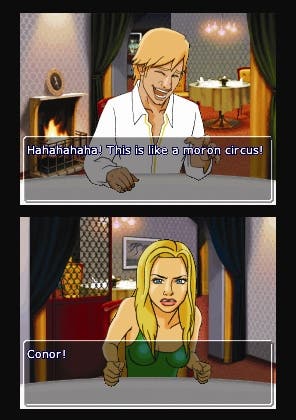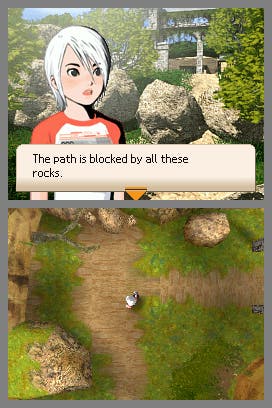Delightfully Strange
A Love Letter to the DS.
The conversation went like this:
So here it is. This is the article intended to stop us banging on about how much we love the DS itself, rather than the game we're supposed to be reviewing. It's the piece to celebrate one of the best things to happen to obscure videogaming in years. It's not Nintendo-sponsored puff. It might sound sycophantic, but that's the cynical earwax that prevents your hearing happiness. It's a guide to the little handheld that could, defying the naysayers' predictions of defeat at the hands of the PSP, standing up to the bullying cries of, "Hey, specky two-screens!" We're getting touchy-feely about the touchy-feely. This is a love letter to the peculiar.
A date with DS-tiny
The DS wasted no time in being odd. In amongst the launch releases were Ping Pals, Feel The Magic XX/XY (Project Rub), Wario Ware: Touched!, Sprung: The Dating Game, and of course, Zoo Keeper. Sure, it had Asphalt Urban GT, Spider-Man 2 and Tiger Woods PGA Tour to feed those looking for the generic, but astonishingly, the oddities outnumbered the mainstream. For goodness sakes, two of them are loosely based around dating.

Sprung is a fairly terrible game. But examine what kind of terrible game. It's a conversation-based dating sim, designed to teach you how to pull members of the opposite sex. Well of course! A relatively popular genre in Japan (let's be honest, there's a fair chance you can interchange the term "weird" for "popular in Japan" for a good portion of this piece), Sprung is a Western attempt at the idea.
Clearly intended to be for boys, the writers' hopeless attempts at creating a female player character are immediately farcical. In the opening conversation, Becky is immediately asking Brett if she can punch him in the face. Punch him in the face. Huh? The confused sexism works in all directions, with Brett assumed to be hopeless, desperately needing Becky's sympathetic guidance, while when playing as Becky she's self-assured and more prone to mock or abuse Brett.
On the other end of the dating game quality spectrum was Feel The Magic XX/XY. Renamed Project Rub in the UK, but originally - and most wonderfully - called I Would Die For You in its native Japan, however you might know it, it was evident of Sega's contraction of the fever spread by DS development. Presenting itself as a game about winning a girl's heart, Rub is purest madness, boiled in a conical flask, then distilled and titrated into silhouette-based cartoon minigames.
Along with its sequel, The Rub Rabbits! (or the infinitely superior Japanese name, Where Do Babies Come From?), it carries the warning, "Do not attempt to recreate any of the scenes in this game". (Something that should more properly have accompanied Sprung). So any who play them, and it should be everyone, will be we advised not to attempt to help a man vomit accidentally swallowed goldfish, enter the correct numbered sequence into a calculator in order to open a parachute, or breathe fire at oncoming robots. Which brings us to another important part of the DS. Breathing.
A breath of fresh air
When Nintendo added a microphone to the machine, it surely can't have intended everyone to use it for blowing on. But aside from booming "HOLD IT!" at Phoenix Wright's bumbling judge (don't worry, we're getting to him), it's rarely used for anything else. From Wario Ware: Touched!'s lunatic minigames to Lost In Blue's fire-starting, the microphone has become little more than an anemometer. And this is testimony to the subject at hand: everything about the DS' design encourages the unusual.

Another Code (or Trace Memory abroad) makes for an interesting example. Essentially a point and click adventure, it was the first suggestion that the DS might provide a home for a genre in exodus. The stylus, should a designer wish, can be a substitute for a mouse, but in a refreshing manner. A mouse and its cursor are a three foot wire apart, but the stylus and its mark are touching. It creates intimacy. It creates a connection between the player and the device, and nothing understands that better than Another Code. Despite being a really very average adventure game, developers CING demonstrated an early depth of the peculiar potential.
Your DS exists within the game, and as something distinct from it. It creates a midpoint between novelty and Verfremdungseffekt. While there are only two good puzzles, they're two really good puzzles, asking you to recognise the DS as a distinct object, separate from the game it's displaying, as well as a tool within the game it's displaying. One requires that you reflect the top screen onto the bottom, emulating a folding glass picture frame found in the game, to reveal a completed image. The other puts an inked woodprint on the top screen, and a piece of paper on the bottom. You have to get the print onto the paper, and no amount of tapping will achieve it. And then, looking around you to make sure no one is watching, and expecting humiliation, you close the DS shut. Opening it reveals the piece of paper decorated with the picture. And breathe out in relief. You were right - the solution is that strange. Nevermind huffing and puffing onto the mic to clear a mirror of dust.

